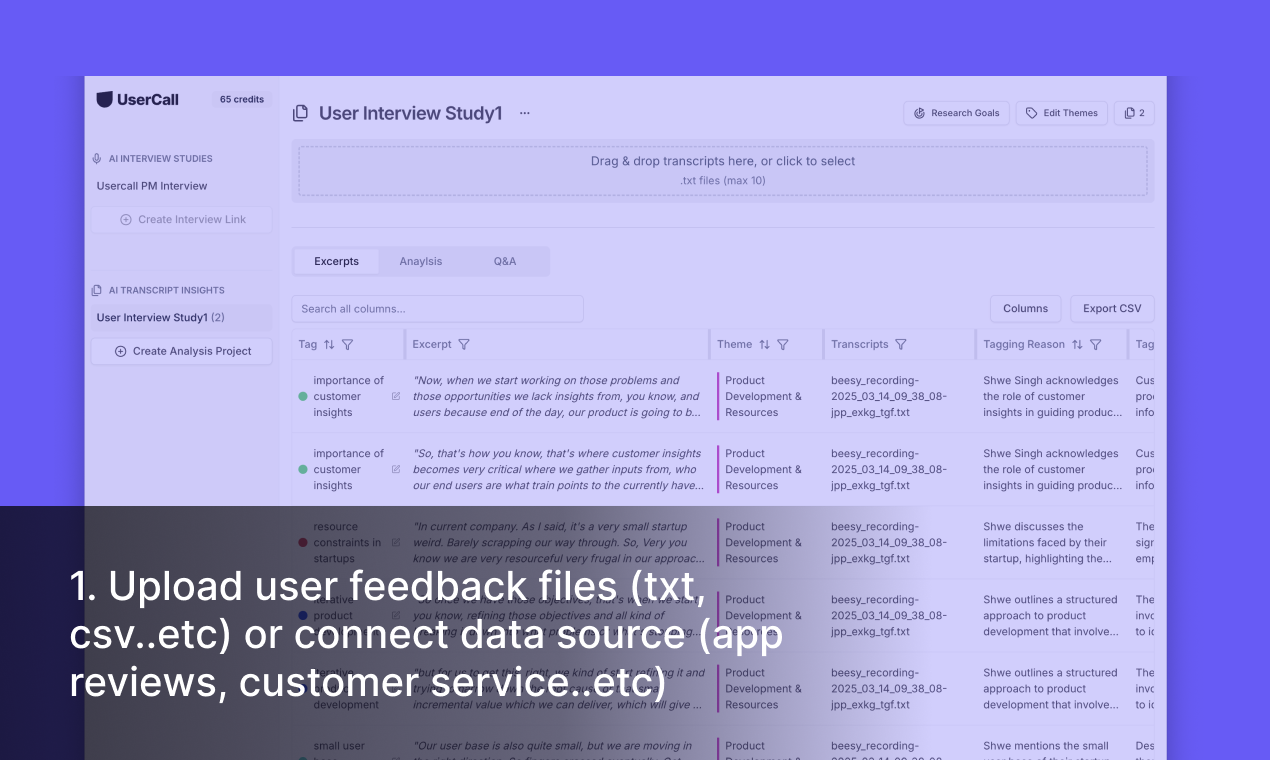Table of Contents
Overview
Drowning in interview transcripts, open-ended survey responses, and customer feedback? Usercall AI Qualitative Analysis offers a powerful solution. This AI-driven tool helps you process qualitative data quickly and efficiently, extracting valuable insights without sacrificing the nuance of individual responses. It promises to transform how you understand your users, customers, and employees. Let’s dive in and see if it lives up to the hype.
Key Features
Usercall AI Qualitative Analysis boasts a range of features designed to streamline your qualitative research process:
- AI-powered thematic analysis: Automatically identifies recurring themes and patterns within your data, saving you hours of manual coding.
- Sentiment & emotion detection: Goes beyond simple keyword analysis to understand the emotional tone and underlying feelings expressed in the text.
- Automated tagging: Automatically tags responses based on identified themes and sentiments, making it easier to filter and analyze your data.
- Multilingual support: Analyze data in multiple languages, expanding your reach and understanding of diverse audiences.
- Integration with research tools: Seamlessly integrates with popular research platforms, streamlining your workflow.
How It Works
Usercall AI simplifies qualitative data analysis with a straightforward process. First, you upload your qualitative data, which can include interview transcripts, survey responses, or any other text-based data. The AI then analyzes the data, detecting recurring patterns, themes, and sentiments. Finally, it presents structured visual summaries, allowing for faster interpretation and a clearer understanding of the key insights hidden within your data. This visual approach helps you quickly grasp the big picture and drill down into specific details.
Use Cases
Usercall AI can be applied across various fields and industries:
- User research analysis: Quickly identify user needs, pain points, and preferences from user interviews and usability testing.
- Customer feedback synthesis: Understand customer sentiment, identify areas for improvement, and track trends in customer satisfaction.
- HR and engagement surveys: Analyze employee feedback to identify areas for improvement in employee engagement and satisfaction.
- Focus group insights: Extract key themes and opinions from focus group discussions, providing a deeper understanding of consumer attitudes.
Pros & Cons
Like any tool, Usercall AI has its strengths and weaknesses. Here’s a balanced look at the advantages and disadvantages:
Advantages
- Fast, accurate insights: Significantly reduces the time required to analyze qualitative data, providing insights much faster than manual methods.
- Supports many languages: Enables analysis of data from diverse global audiences.
- Reduces manual workload: Automates tedious tasks like coding and tagging, freeing up researchers to focus on interpretation and strategy.
Disadvantages
- Requires onboarding: Like any new tool, there’s a learning curve involved in getting started and mastering all the features.
- Some features may be paywalled: Access to certain advanced features may require a paid subscription.
How Does It Compare?
When considering AI-powered qualitative analysis tools, it’s important to understand how Usercall AI stacks up against the competition.
- Usercall AI vs. Dovetail: Dovetail often requires more manual input and coding, while Usercall AI automates much of the process. Dovetail offers collaborative tools which Usercall AI may lack.
- Usercall AI vs. Reframer: Reframer offers a broader suite of workflow tools, but it can be pricier than Usercall AI.
Final Thoughts
Usercall AI Qualitative Analysis offers a compelling solution for anyone struggling to make sense of large volumes of qualitative data. Its AI-powered features promise to accelerate the analysis process, uncover hidden insights, and ultimately lead to better-informed decisions. While the onboarding process and potential paywalls are worth considering, the time savings and enhanced understanding it provides may make it a worthwhile investment for researchers, marketers, and HR professionals alike.
